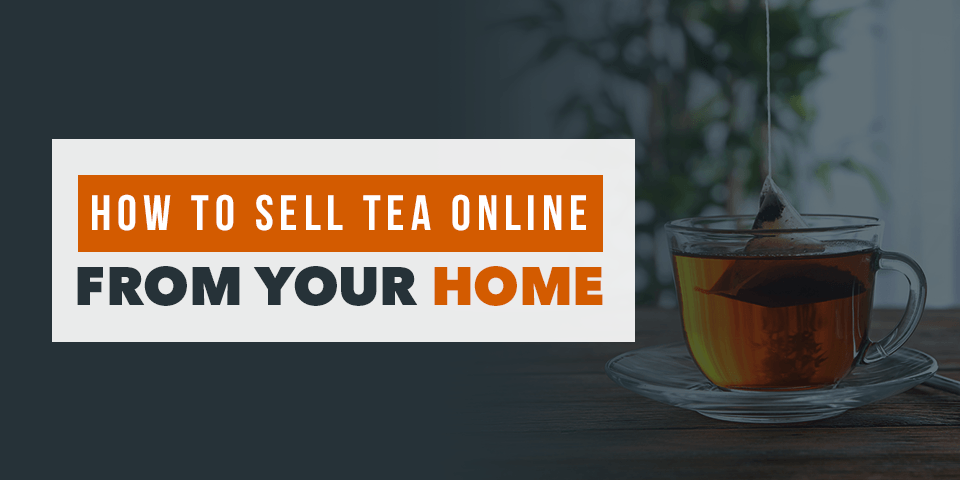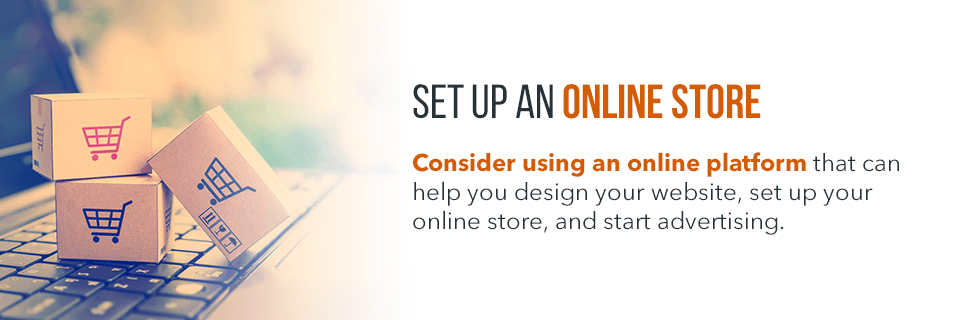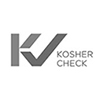
If you love to sit down with a hot cup of tea, you’re not alone. Next to water, tea is the most widely consumed beverage in the entire world. In the U.S. alone, you’ll find some form of tea in about 80% of households. Tea may be consumed hot or cold, day or night, and for any occasion.
Tea has been around for almost 5,000 years, and due to its health benefits, convenience, and sustainability, the industry is not expected to slow down. If you’re passionate about tea and its great abilities to soothe, energize, and quench your thirst, you may be interested in starting a tea business of your own. With the option to sell tea products online, your dream can become a reality with little startup costs.

How to Start Selling Tea Online from Your Home
Starting a tea business can be exciting and rewarding, whether you’re ready to commit full-time or looking for a fun and creative part-time job. With so many varieties of teas and other ingredients available, there are tons of ways to build a unique brand and quality product. In this guide, we’ll show you the basics of how to start a tea business at home so you can put your ideas in motion.
Start with an Idea
Before you begin your tea business, you need an idea that will differentiate you from competitors. Ask yourself the following questions:
- What type of product do I want to sell? First, you need to decide what kind of tea product you plan to sell. Do you want to focus on hot or cold beverages? Are you passionate about creating flavored blends, or are you more interested in organic products? Think about how you like to drink tea and what you enjoy producing.
- What’s already out there? Research other tea brands and think about what makes them successful. Consider how they package their products, the benefits they offer, and who buys their tea. Then, try to think of a new tea product that will set you apart.
- What’s my purpose? What purpose do you want your tea to serve? Do you want your product to be about flavor, or do you want to focus on health benefits? Also, think about what consumers want and let that inspire you. For example, green tea is one of the most popular types of tea. If you want to appeal to a wide audience, you might consider developing a unique green tea product.
- What’s my company’s name? The name of your company is critical to your success. Your name impacts how customers perceive your company and determines whether they will remember your product or not. Aim to select a name and logo that captures the essence of your brand and sticks in customers’ minds.
Create Your Business Entity
Most businesses need to register with their state to become a legal entity. Depending on where you live, you may be able to register online, or you might have to submit paper documents by mail or in person. You’ll also need to apply for an Employer Identification Number (EIN) with the IRS, which you’ll need to file taxes.
Lastly, you might have to apply for specific permits in your city or state. Get in touch with your local government to find out what you need to do to start your online tea business.
Learn More About Launching Your Tea Business Today
Set up an Online Store

As an online tea seller, you’ll need a way to complete transactions securely. Your website will also be your storefront, so it needs to appeal to customers and promote a simple and enjoyable shopping experience. It’s best to keep the design clean with basic fonts and limited media. You want each page to load fast and be easy on the eyes.
There are plenty of ways to build an attractive and intuitive website, whether you’re an experienced web designer or a beginner. Consider using an online platform that can help you design your website, set up your online store, and start advertising. As no two platforms are the same, make sure to research each one until you find the right fit. You could also consider hiring a professional web developer to build your online store. Hiring a pro can vary significantly in cost, depending on your needs.
Once you have your website up and running, you can start adding content right away. For example, you could create helpful tea-themed blog posts to build your audience and spread brand awareness. When you’re ready to start selling your tea, make sure your product pages feature clear photos and brief, honest descriptions.
Find Your Customers
When it’s time to market your product, you need to know your audience and who you’re trying to reach. Knowing your customer base will help you communicate effectively and to the right people. It also enables you to focus as you develop and package your product.
To identify your customers and who you wish to target, ask yourself some questions: Do you want to appeal to consumers who buy ready-to-drink tea products? Or are you aiming to target tea connoisseurs who value freshness over unique blends? Maybe you want to create beverages that dieters can enjoy as satisfying alternatives to high-calorie drinks.
Either way, you must know who you’re selling to, as this will help shape your product and your marketing efforts. Here are tips to help you define your target market:
- Investigate competitors’ customers: Research competitors who are selling teas similar to yours and find out more about their audience. Who are they selling to, and what are their interests? The goal isn’t to target the same customers, but to find a gap in the market and fill a niche.
- Analyze your tea: Make a list of every feature of your drink and the benefit it provides. For example, if your beverage is calorie-free, its advantage is that it can help dieters reach their goals. After you list each bonus, describe the people who need the benefits your product provides. This will help you form your customer base.
- Consider demographics: You also want to think about demographics and who is most likely to buy your tea. This includes investigating factors such as age, gender, and income level.
- Think about personal characteristics: Besides demographics, think about your audience’s personality, values, and hobbies and how your product fits. For example, does your potential customer value sustainability? If so, consider how you can incorporate sustainability in your product and package design.
Lastly, evaluate what you’ve come up with so far. Do you have a wide enough audience who will see a need for your tea, and who can afford your product? If it turns out your customer base is too small, you may need to make a few adjustments to your product or brand identity. Once you find your audience, you’ll have a much easier time marketing your product, connecting with your customers, and generating interest.
Develop the Product Line
Now the important part — creating a product your customers will love. It’s essential to create a quality product and to get it right the first time. Your customers may leave reviews on social media sites or mention your tea in their blog. Their reviews will influence other customers and their decision to buy your tea. Therefore, your product must meet, or ideally exceed, your customers’ expectations. You have several paths you can take regarding product development, but the main tea groups are:
- Flavored teas and blends: This is the route to take if you want to appeal to customers who enjoy tasty tea flavors or combinations. You can purchase supplies from wholesalers and experiment with tea flavors at home. For example, many blends start with a true tea as a base and then include dried fruits, flowers, spices, or herbs for flavor. True teas are those derived from the Camellia Sinensis plant and include green tea, black tea, and white tea. You can either purchase base teas to create blends on your own, or work with a private label tea manufacturer who will produce and package your tea to your exact specifications.
- Single-origin teas: Single-origin teas allow consumers to sample tea from a particular region, unlike blended teas, which combine ingredients from various places. Teas grown in different parts of the world have distinct flavors and may even taste different, depending on the time of year the tea was produced. You can purchase single-origin teas from a wholesaler, but if you want something more unique, consider searching for tea growers on your own.
You won’t need to have an extensive product line at the start of your business because you can gradually add teas over time.
Design the Packaging

After customers purchase tea from your website, you’ll have another opportunity to make a lasting impression with the packaging. The packaging can be simple, but it should make a customer feel excited to see what’s inside.
Consider the outside of the box, how the product is wrapped inside, and the container you use to hold the tea. Tea companies commonly use zipper pouches or tins with stick-on labels. Packaging should feature your logo, steeping instructions, tea name, the amount of tea inside, a brief description, and possibly a picture. You might want to create a sample box or draw up a design to see your ideas come to life. To create packaging that makes an impact, here are some tips:
- Focus on color: Use the power of color psychology to convey your brand’s values and personality. For example, if you want customers to associate your tea with health, consider using green in the label. If you want to convey elegance, add gold elements. Experiment with various colors until you find a design that fits.
- Incorporate movement: Consider using images on the packaging that feature some motion. Customers are more inclined to purchase items that “move.”
- Include certifications or awards: Make sure to include any relevant certifications, such as a USDA Organic Certification, on your tea packaging to appeal to customers and showcase your values.
- Add graphics: Consider how unique, beautiful artwork can be placed on the packaging to catch customers’ attention and convey certain emotions or ideas.
If you need help creating a design that packs a punch, reach out to a custom packaging service. At Joe’s Garage Coffee, we’ll work with you to design and produce creative, eye-catching packaging.
Learn More About Launching Your Tea Business Today
Market Your Tea
Once you have your product and packaging ready to go, you need to focus on marketing and getting your tea out there. You have several options when it comes to advertising your tea at little to no cost. One place to start is a social media platform like Twitter or Facebook.
For example, you can promote your product on Twitter for free by joining a conversation about tea and obtaining followers who may eventually buy your product. The point of using Twitter as a marketing tool is to engage with potential customers, build trust, and generate interest.
Instagram is another excellent tool for promoting your brand. Share colorful, appealing photos of your teas and get people excited about your product and your brand’s story.
3 Benefits of Selling Tea from Your Home

As a tea lover, you know the comfort of drinking tea at home. Selling tea from your home has several benefits, too, such as:
- Unlimited hours: When you run an online business, you can allow customers to browse your store and place orders from anywhere in the world, 24/7. This gives you instant access to a more extensive customer base and increases the number of orders. To customers, always-open status is convenient and allows them to shop whenever they want.
- Lower costs: An online store means you don’t have to pay rent for a retail space, buy furniture, or hire employees. This saves you a significant amount of money and allows you to put profits toward bettering your product, brand, and marketing strategies.
- Greater flexibility: You can manage your business from anywhere following a schedule you like. So, if you prefer to work in the middle of the night on your laptop in the backyard, no one can stop you.
The Health Benefits of Drinking Tea
Tea is a healthy drink option. When you enter the tea business, you get to offer consumers something soothing and beneficial to their health — another reason to celebrate your entrepreneurial journey. The benefits of drinking tea include:
- Health benefits: According to one study, there are hundreds of scientific publications documenting tea’s ability to help prevent cancer. Many of these studies show that the natural antioxidants in tea may lower the risk of various forms of cancer, such as skin, lung, and breast cancer. Tea is also associated with increased cardiovascular health and has been shown to reduce the risk of stroke and heart disease.
- Calorie-free: A plain cup of tea has less than five calories. So, as long as the drinker avoids adding milk and sugar, they can enjoy a flavorful beverage while sticking to their weight loss plan.
- Caffeine-free options: Generally, herbal teas contain no caffeine. Individuals who are sensitive to caffeine or who want something relaxing to drink at night can benefit from sipping herbal tea.
Start a Tea Business with Joe’s Garage Coffee
If you’ve had ideas brewing in your head and are ready to start a tea business at home, we’re prepared to help you succeed. Our private label tea experts look forward to partnering with you to develop your ideas and package design. To learn more about our services and how we can help you start a tea business, contact us today.
Related Content










